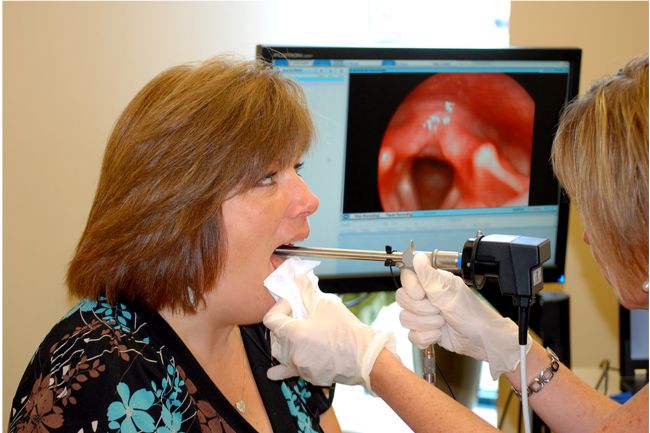Voice Lab

S.L. HUNTER SpeechWorks is pleased to offer its clients a fully equipped voice lab, complete with Videostroboscopy and Visi-Pitch Acoustic Analysis in order to evaluate and treat a variety of voice and resonance disorders.
What is a voice disorder?
Voice disorders can develop at any age and may be characterized by hoarseness, breathiness, strained and/or unpredictable voice quality. There may or may not be associated sensation of pain, strain or tension in the throat or neck muscles.
Common causes of voice disorders include vocal abuse (e.g. yelling, screaming, excessive throat clearing), overuse of the voice, or vocal misuse (e.g. prolonged speaking at an elevated pitch level).
The voice can be lost temporarily due to overuse, laryngitis, or viral infection. If symptoms persist for an extended period they will likely not resolve on their own and may even worsen over time.
Do I have a voice disorder?
-
Does your voice sound hoarse or raspy on a regular basis?
-
Does your voice sound deeper/lower than it used to be?
-
Does your throat feel tight, raw, or sore?
-
Does speaking require more effort?
-
Do you clear your throat frequently?
-
Have you experienced reduced pitch range (e.g. more difficulty reaching high notes)?
If you answered YES to any of these questions, consult an Otolaryngologist or Ear Nose and Throat doctor (ENT) who can determine the underlying cause of the voice disorder. The Speech-Language Pathologist can provide education on healthy voice use, teaching effective voicing techniques in order to eliminate the voice problem, prevent future occurrence, and in many cases can provide treatment to avoid surgical intervention that may have otherwise been necessary.
What is included in the Voice Assessment?
The Speech-Language Pathologist will meet with you to take a detailed case history. Voice recordings will be taken to evaluate voice use across a variety of speaking tasks. A Visi-Pitch instrumental acoustic analysis will evaluate vocal quality, such as pitch and volume. A Videostroboscopy will be conducted to look at the structure and function of the vocal cords; recorded images of your “voice box” and vocal cords will be taken and analyzed. An ENT colleague will be consulted if appropriate. The Speech-Language Pathologist will make recommendations for the best treatment approach to meet your vocal needs.
What is Visi-Pitch Acoustic Analysis?
Analysis is conducted through a computer based program used to measure voice output through analysis of pitch, volume, and prosody (rate, rhythm, intonation) during speaking tasks. The multi-dimensional voice profile provides a visual representation of the voice. The data gathered assists with evaluation of the voice disorder, refines treatment goals, and provides a baseline of the voice. The Visi-Pitch is also a valuable biofeedback tool used during the treatment process.
What is Videostroboscopy?
Videostroboscopy provides key information needed in the investigation of voice disorders by pinpointing the underlying problem or problems with vocal cord vibration so treatment can be directed appropriately. Videostroboscopy is a much more sensitive tool and more helpful in identifying subtle issues with the “voice box” over other techniques, such as rigid or flexible transnasal laryngoscopy with continuous light sources. While a laryngoscopy helps identify problems of a general nature, a videostroboscopy provides a more detailed view and can reveal problems with the vocal cords such as lesions or irregularities in their vibration.
Videostroboscopy uses a flashing light source to create a slow motion view of vocal cord vibration. Vocal cord vibration is very fast thus the “slow motion” view is actually taken from many successive rounds of vibration. This unique viewing allows the voice care team to look at how each vocal cord vibrates during the different phases of the vocal cord’s vibration cycle, allowing for clear identification of smaller abnormalities in vocal cord movement that are unable to be observed using any other technique.
Who is a candidate for Videostroboscopy?
Videostroboscopy is highly recommended when a voice disorder is due to abnormalities that affect vocal cord vibration. These abnormalities can include:
-
vocal cord scarring
-
a mass (cyst, polyp, nodule)
-
incomplete closure of the vocal cords
-
abnormal vocal cord vibration
-
asymmetrical/uneven movement of the vocal cords